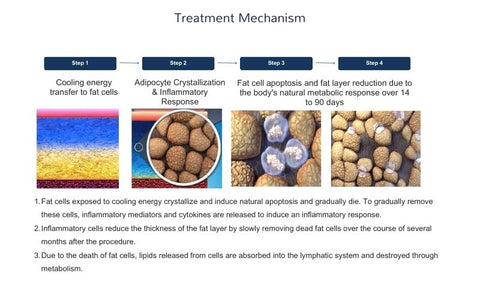Understanding Fat Freezing Technology: Does Fat Freezing Actually Work?
In an age where sleek, sculpted physiques dominate our social media feeds, it's no surprise that cutting-edge treatments promising fat loss without the scalpel have captured our collective imagination. Among these, fat freezing, medically known as cryolipolysis, stands out as a beacon of hope for many striving to shed stubborn fat pockets. But the critical question lingers in the air like a tantalizing promise – does fat freezing actually work?
Tracing its roots back to an unexpected observation involving children, popsicles, and cheek dimples, fat freezing has evolved from a mere curiosity to a globally embraced technology. Picture this: researchers at Harvard University stumbled upon a curious phenomenon where children eating popsicles developed dimples due to the loss of fat cells in their cheeks – a process termed 'Popsicle Panniculitis'. This serendipitous discovery sparked a wave of scientific inquiry leading to the birth of fat freezing as we know it today.
What started in the frosty halls of academia has now thawed into a worldwide craze. This non-invasive technique, which claims to bid farewell to fat cells by freezing them, has emerged as a sought-after alternative to traditional fat-reduction methods. But beyond the hype and glossy clinic brochures, we delve into the heart of the matter: Is fat freezing a revolutionary solution to our fat woes or just a frosty fad?
In this comprehensive exploration, we'll unravel the science behind fat freezing, scrutinize its effectiveness, and weigh its merits against other fat reduction strategies. So, whether you're a skeptic, an enthusiast, or simply curious, join us on this chilly journey to uncover the truth about fat freezing. Could this be the key to unlocking a leaner, more sculpted you?

Origins of Fat Freezing: From Popsicles to Cryolipolysis
The journey of fat freezing, from a peculiar observation to a groundbreaking cosmetic procedure, reads almost like a fairy tale. It began not in a high-tech laboratory, but in the simple, everyday world of children enjoying popsicles. This is the story of how a humble snack led to one of the most significant advancements in non-invasive fat reduction: cryolipolysis.
In the early 2000s, Dr. Dieter Manstein and Dr. R. Rox Anderson of Harvard University made a remarkable observation. They noted that children who frequently ate popsicles developed cheek dimples. Intrigued, these doctors delved deeper, hypothesizing that the cold from the popsicles was selectively affecting and eliminating small pockets of fat cells in the children's cheeks. This phenomenon was termed 'Popsicle Panniculitis', and it laid the foundation for cryolipolysis.
The Harvard researchers' breakthrough hinged on a simple yet profound realization: fat cells are more vulnerable to cold injury than other surrounding tissues. This vulnerability is due to the unique composition and properties of fat cells. When exposed to controlled cooling, these cells crystallize, break down, and eventually die, a process known as apoptosis. The most remarkable part? This occurs without causing harm to the overlying skin, nerves, or surrounding structures.
This discovery set the stage for extensive research. Manstein and Anderson embarked on a series of experiments, meticulously testing and refining their understanding of how cold affects fat cells. Their research culminated in the development of a technology that could safely, effectively, and selectively target fat cells with controlled cooling, leading to their natural elimination from the body.
The first commercial cryolipolysis machine, known popularly as CoolSculpting, received FDA clearance in 2010. This approval marked a significant milestone, officially introducing fat freezing as a safe and effective cosmetic treatment for fat reduction. The technology has since evolved, with numerous advancements enhancing its safety, efficacy, and range of treatable areas.
Today, fat freezing stands as a testament to the power of curiosity and scientific inquiry. It reminds us that sometimes, great innovations can stem from the simplest of observations. What began with children and popsicles has transformed into a sophisticated technique that has helped countless individuals reshape their bodies and boost their self-confidence.

Scientific Explanation of Fat Freezing: The Cryolipolysis Process
At its core, fat freezing, or cryolipolysis, is a scientific method designed to reduce fat in specific body areas. This technology doesn't rely on mere cold exposure, but on a sophisticated process that targets fat cells while sparing other tissues. To truly appreciate this technique, let's delve into the science behind it, demystifying how it freezes fat away.
The Selective Vulnerability of Fat Cells
The groundbreaking idea behind fat freezing is based on one key principle: fat cells are more sensitive to cold than other types of cells in our body. This sensitivity is due to the unique properties of the lipid content in fat cells. Unlike other cellular structures, these lipids crystallize at higher temperatures than surrounding water-rich tissues. Therefore, when exposed to specific cold temperatures, fat cells reach a freezing point before other cells do.
The Cryolipolysis Process
Cryolipolysis works by applying controlled cooling to the targeted area, usually between -5 to -11 degrees Celsius (23 to 12 degrees Fahrenheit). This cooling is carefully monitored and sustained for a predetermined period, typically around 35 to 60 minutes per session. The device used for this procedure comes with applicators that draw in the bulges of fat using a vacuum mechanism.
Once the fat cells are exposed to these temperatures, they undergo a natural process called apoptosis, or programmed cell death. Here's the fascinating part: while the fat cells freeze and eventually die, the surrounding skin, muscle, and nerve tissues remain unharmed. This selective targeting is what makes cryolipolysis a safe and effective procedure.
The Body's Response to Frozen Fat Cells
After the fat cells are crystallized and commence the apoptosis process, the body's immune system naturally takes over. The lymphatic system, a critical part of our immune system, gradually absorbs these damaged fat cells. Over time, these cells are processed and eliminated from the body as waste. This process isn't immediate; it typically takes several weeks to months for the body to remove the targeted fat cells completely.
Long-Term Effects
One of the most compelling aspects of cryolipolysis is the permanence of its results. Once the fat cells are eliminated, they don't regenerate or reappear in the treated area. However, this doesn't prevent new fat cells from forming due to weight gain. Therefore, maintaining a healthy lifestyle is crucial for sustaining the results.
Safety and Efficacy
Numerous clinical studies have validated the safety and effectiveness of cryolipolysis. When performed by trained professionals, the risk of side effects is minimal. The most commonly reported sensations during the procedure are suction and intense cold, which typically subside as the area becomes numb.
